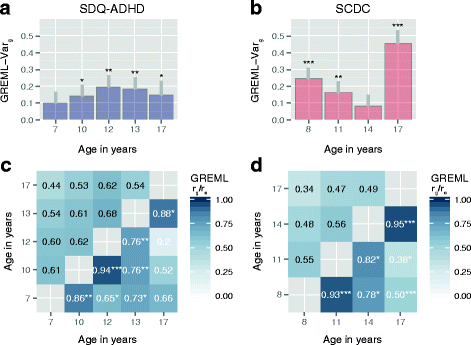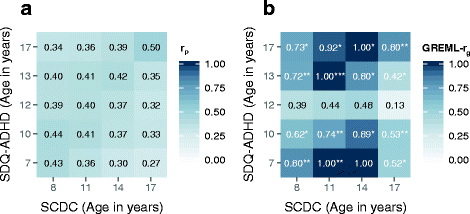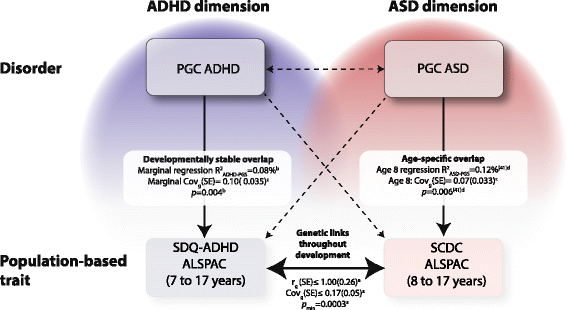Shared genetic influences between dimensional ASD and ADHD symptoms during child and adolescent development
- PMID: 28392908
- PMCID: PMC5379648
- DOI: 10.1186/s13229-017-0131-2
Shared genetic influences between dimensional ASD and ADHD symptoms during child and adolescent development
Abstract
Background: Shared genetic influences between attention-deficit/hyperactivity disorder (ADHD) symptoms and autism spectrum disorder (ASD) symptoms have been reported. Cross-trait genetic relationships are, however, subject to dynamic changes during development. We investigated the continuity of genetic overlap between ASD and ADHD symptoms in a general population sample during childhood and adolescence. We also studied uni- and cross-dimensional trait-disorder links with respect to genetic ADHD and ASD risk.
Methods: Social-communication difficulties (N ≤ 5551, Social and Communication Disorders Checklist, SCDC) and combined hyperactive-impulsive/inattentive ADHD symptoms (N ≤ 5678, Strengths and Difficulties Questionnaire, SDQ-ADHD) were repeatedly measured in a UK birth cohort (ALSPAC, age 7 to 17 years). Genome-wide summary statistics on clinical ASD (5305 cases; 5305 pseudo-controls) and ADHD (4163 cases; 12,040 controls/pseudo-controls) were available from the Psychiatric Genomics Consortium. Genetic trait variances and genetic overlap between phenotypes were estimated using genome-wide data.
Results: In the general population, genetic influences for SCDC and SDQ-ADHD scores were shared throughout development. Genetic correlations across traits reached a similar strength and magnitude (cross-trait rg ≤ 1, pmin = 3 × 10-4) as those between repeated measures of the same trait (within-trait rg ≤ 0.94, pmin = 7 × 10-4). Shared genetic influences between traits, especially during later adolescence, may implicate variants in K-RAS signalling upregulated genes (p-meta = 6.4 × 10-4). Uni-dimensionally, each population-based trait mapped to the expected behavioural continuum: risk-increasing alleles for clinical ADHD were persistently associated with SDQ-ADHD scores throughout development (marginal regression R2 = 0.084%). An age-specific genetic overlap between clinical ASD and social-communication difficulties during childhood was also shown, as per previous reports. Cross-dimensionally, however, neither SCDC nor SDQ-ADHD scores were linked to genetic risk for disorder.
Conclusions: In the general population, genetic aetiologies between social-communication difficulties and ADHD symptoms are shared throughout child and adolescent development and may implicate similar biological pathways that co-vary during development. Within both the ASD and the ADHD dimension, population-based traits are also linked to clinical disorder, although much larger clinical discovery samples are required to reliably detect cross-dimensional trait-disorder relationships.
Keywords: ADHD symptoms; ALSPAC; Clinical ADHD; Genetic overlap; Social communication.
Figures




Similar articles
-
ASD and schizophrenia show distinct developmental profiles in common genetic overlap with population-based social communication difficulties.Mol Psychiatry. 2018 Feb;23(2):263-270. doi: 10.1038/mp.2016.198. Epub 2017 Jan 3. Mol Psychiatry. 2018. PMID: 28044064 Free PMC article.
-
Inattention and hyperactive/impulsive component scores do not differentiate between autism spectrum disorder and attention-deficit/hyperactivity disorder in a clinical sample.Mol Autism. 2020 Apr 25;11(1):28. doi: 10.1186/s13229-020-00338-1. Mol Autism. 2020. PMID: 32334619 Free PMC article.
-
Genetic risk for attention-deficit/hyperactivity disorder contributes to neurodevelopmental traits in the general population.Biol Psychiatry. 2014 Oct 15;76(8):664-71. doi: 10.1016/j.biopsych.2014.02.013. Epub 2014 Feb 25. Biol Psychiatry. 2014. PMID: 24673882 Free PMC article.
-
Infant regulatory function acts as a protective factor for later traits of autism spectrum disorder and attention deficit/hyperactivity disorder but not callous unemotional traits.J Neurodev Disord. 2019 Jul 18;11(1):14. doi: 10.1186/s11689-019-9274-0. J Neurodev Disord. 2019. PMID: 31351456 Free PMC article. Review.
-
Twin studies and their implications for molecular genetic studies: endophenotypes integrate quantitative and molecular genetics in ADHD research.J Am Acad Child Adolesc Psychiatry. 2010 Sep;49(9):874-83. doi: 10.1016/j.jaac.2010.06.006. Epub 2010 Jul 31. J Am Acad Child Adolesc Psychiatry. 2010. PMID: 20732624 Free PMC article. Review.
Cited by
-
Predicting Polygenic Risk of Psychiatric Disorders.Biol Psychiatry. 2019 Jul 15;86(2):97-109. doi: 10.1016/j.biopsych.2018.12.015. Epub 2018 Dec 28. Biol Psychiatry. 2019. PMID: 30737014 Free PMC article. Review.
-
Longitudinal association between the duration of eye gaze fixation on social information and specific symptoms of neurodevelopmental disorders in children: A large-scale community-based cohort study.PCN Rep. 2025 May 19;4(2):e70095. doi: 10.1002/pcn5.70095. eCollection 2025 Jun. PCN Rep. 2025. PMID: 40391067 Free PMC article.
-
The contribution of common genetic risk variants for ADHD to a general factor of childhood psychopathology.Mol Psychiatry. 2020 Aug;25(8):1809-1821. doi: 10.1038/s41380-018-0109-2. Epub 2018 Jun 22. Mol Psychiatry. 2020. PMID: 29934545 Free PMC article.
-
Analysis of structural brain asymmetries in attention-deficit/hyperactivity disorder in 39 datasets.J Child Psychol Psychiatry. 2021 Oct;62(10):1202-1219. doi: 10.1111/jcpp.13396. Epub 2021 Mar 22. J Child Psychol Psychiatry. 2021. PMID: 33748971 Free PMC article.
-
Social difficulties in youth with autism with and without anxiety and ADHD symptoms.Autism Res. 2018 Dec;11(12):1679-1689. doi: 10.1002/aur.2039. Epub 2018 Nov 26. Autism Res. 2018. PMID: 30475451 Free PMC article.
References
-
- Mulligan A, Anney RJL, O’Regan M, Chen W, Butler L, Fitzgerald M, et al. Autism symptoms in attention-deficit/hyperactivity disorder: a familial trait which correlates with conduct, oppositional defiant, language and motor disorders. J Autism Dev Disord. 2008;39:197–209. doi: 10.1007/s10803-008-0621-3. - DOI - PubMed
Publication types
MeSH terms
Grants and funding
LinkOut - more resources
Full Text Sources
Other Literature Sources
Medical
Miscellaneous

